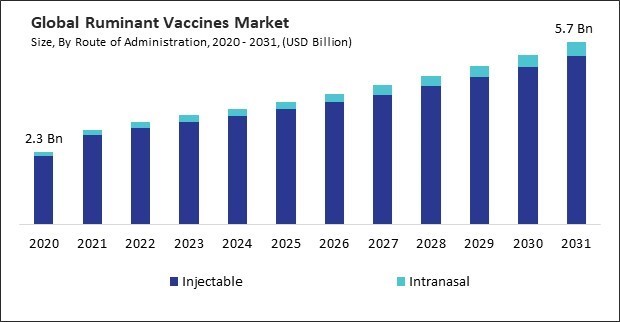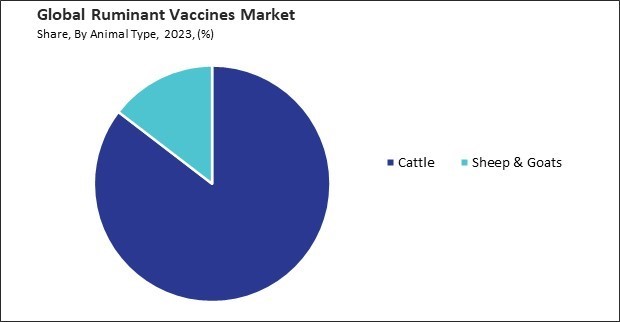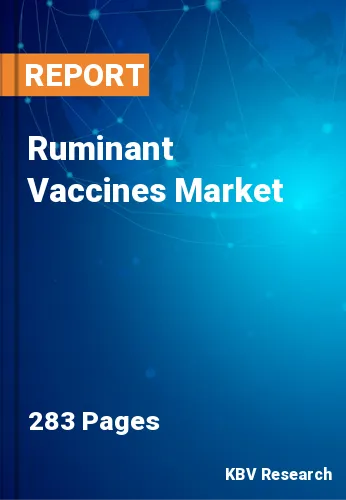“Global Ruminant Vaccines Market to reach a market value of USD 5.7 Billion by 2031 growing at a CAGR of 6.7%”
The Global Ruminant Vaccines Market size is expected to reach $5.7 billion by 2031, rising at a market growth of 6.7% CAGR during the forecast period.
BVD is a highly economically significant disease in cattle, causing substantial losses to the livestock industry worldwide. Effective vaccinations to prevent and control BVD are in high demand due to the economic burden of outbreaks. Consequently, the BVD infection segment would acquire nearly, 30% market share by2031. The disease reduces productivity, including decreased milk production, weight loss, reduced reproductive performance, increased veterinary costs, and increased susceptibility to secondary infections.

The demand for foods high in protein, such as meat, milk, and dairy products, is rising along with the world's population. Additionally, urbanization trends often lead to changes in dietary habits. This creates a substantial market opportunity for ruminant vaccines, as producers strive to comply with regulations and ensure the health and safety of their animals. Thus, the increasing demand for livestock products drives the market’s growth. Additionally, the emergence and spread of infectious illnesses are made possible by the intensification of livestock production systems, which is a result of population growth and an increase in the demand for animal products. Therefore, the growing prevalence of infectious diseases is propelling the growth of the market.
However, Vaccination programs require significant financial investment from farmers, particularly those operating on small or medium scales with limited resources. The cost of purchasing vaccines and associated expenses such as storage, administration, and veterinary services can strain farm budgets. Also, vaccines’ production, distribution, and storage entail logistical challenges that can contribute to their high cost. Therefore, the high cost of vaccines Is impeding the market’s growth.
The COVID-19 pandemic disrupted global supply chains, affecting the production and distribution of veterinary vaccines, including vaccines. Restrictions on movement, lockdown measures, and transportation disruptions led to delays in vaccine manufacturing, shortages of raw materials, and logistical challenges in vaccine distribution. Similarly, healthcare resources and attention primarily focused on combating COVID-19 during the pandemic. These changes had implications for disease transmission dynamics and vaccination strategies in ruminant populations, influencing vaccine demand. Thus, the COVID-19 pandemic had a negative impact on the market.
Based on animal type, the market is divided into cattle and sheep & goats. The sheep & goats segment procured a 14.95% revenue share in the market in 2023. The sheep and goat industry are experiencing growth globally, driven by increasing demand for meat, milk, and fiber products. There is an increasing focus on high-quality, sustainable animal production as the population expands and customer demands change. This production growth creates a greater need for disease prevention and control measures, including vaccination, to ensure the health and productivity of sheep and goat populations.

On the basis of vaccines type, the market is segmented into modified/ attenuated live, inactivated (killed), and others. In 2023, the inactivated (killed) segment attained a 34.15% revenue share in the market. Inactivated vaccines are generally more stable and have longer shelf lives. Inactivated vaccines’ stability and shelf life make them suitable for use in remote or resource-limited areas.
By route of administration, the market is bifurcated into injectable and intranasal. The intranasal segment procured a 5.68% revenue share in the market in 2023. Intranasal vaccines offer a non-invasive route of administration, as they are administered through the nasal passages rather than by injection. This non-invasive approach reduces animal stress and discomfort during vaccination, making intranasal vaccines particularly suitable for use in ruminants that may be difficult to handle or restrain for injection.
Based on indication, the market is categorized into BVD infection, bovine respiratory diseases (BRD), leptospirosis, clostridial diseases, diarrhea/ scours, FMD, and others. The clostridial diseases segment attained a 16.76% revenue share in the market in 2023. Clostridial diseases, such as blacklegs (Clostridium chauvoei), malignant edema (C. septicum), tetanus (C. tetani), and enterotoxemia (C. perfringens types C and D), can cause severe and often fatal infections in livestock. The devastating impact of clostridial diseases on animal health drives demand for effective vaccines to prevent disease outbreaks and reduce mortality rates.
Free Valuable Insights: Global Ruminant Vaccines Market size to reach USD 5.7 Billion by 2031
Region-wise, the market is analyzed across North America, Europe, Asia Pacific, and LAMEA. The North America region witnessed 36% revenue share in the ruminant vaccines market in 2023. North American livestock producers prioritize animal health and welfare to maintain the quality and integrity of their products. By investing in vaccination programs and disease management strategies, North American producers aim to ensure the well-being of their livestock and meet consumer expectations for safe and wholesome meat and dairy products.
| Report Attribute | Details |
|---|---|
| Market size value in 2023 | USD 3.4 Billion |
| Market size forecast in 2031 | USD 5.7 Billion |
| Base Year | 2023 |
| Historical Period | 2020 to 2022 |
| Forecast Period | 2024 to 2031 |
| Revenue Growth Rate | CAGR of 6.7% from 2024 to 2031 |
| Number of Pages | 283 |
| Number of Tables | 460 |
| Report coverage | Market Trends, Revenue Estimation and Forecast, Segmentation Analysis, Regional and Country Breakdown, Porter’s 5 Forces Analysis, Company Profiling, Companies Strategic Developments, SWOT Analysis, Winning Imperatives |
| Segments covered | Animal Type, Vaccines Type, Route of Administration, Indication, Region |
| Country scope |
|
| Companies Included | Boehringer Ingelheim International GmbH, Zoetis, Inc., Merck & Co., Inc., Bimeda, Inc., Elanco Animal Health, Inc., Virbac, Ceva Sante Animale, CZ Vaccines S.A.U. (Zendal Health S.A.), Indian Immunologicals Ltd. (National Dairy Development Board), Vaxxinova International BV (EW Group) |
By Animal Type
By Vaccines Type
By Route of Administration
By Indication
By Geography
The Market size is projected to reach USD 5.7 billion by 2031.
Increasing demand for livestock products are driving the Market in coming years, however, Logistical challenges in distribution of vaccines restraints the growth of the Market.
Boehringer Ingelheim International GmbH, Zoetis, Inc., Merck & Co., Inc., Bimeda, Inc., Elanco Animal Health, Inc., Virbac, Ceva Sante Animale, CZ Vaccines S.A.U. (Zendal Health S.A.), Indian Immunologicals Ltd. (National Dairy Development Board), Vaxxinova International BV (EW Group)
The expected CAGR of this Market is 6.7% from 2024 to 2031.
The Injectable segment is leading the Market by Route of Administration in 2023; thereby, achieving a market value of $5.2 billion by 2031.
The North America region dominated the Market by Region in 2023; thereby, achieving a market value of $1.9 billion by 2031.
Our team of dedicated experts can provide you with attractive expansion opportunities for your business.

 Drivers
Drivers
 Restraints
Restraints
 Opportunities
Opportunities
 Challenges
Challenges
